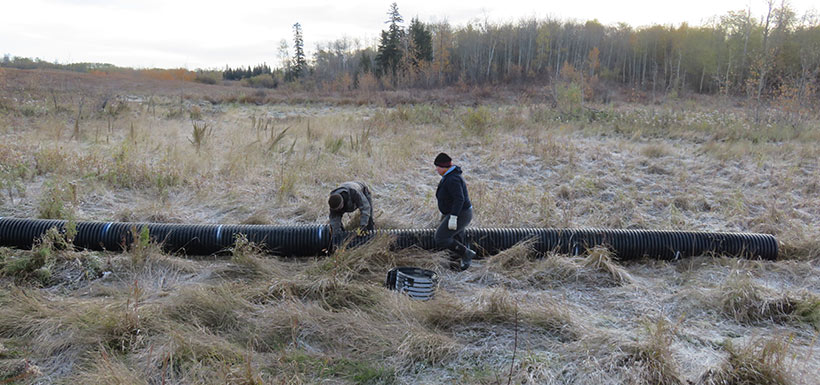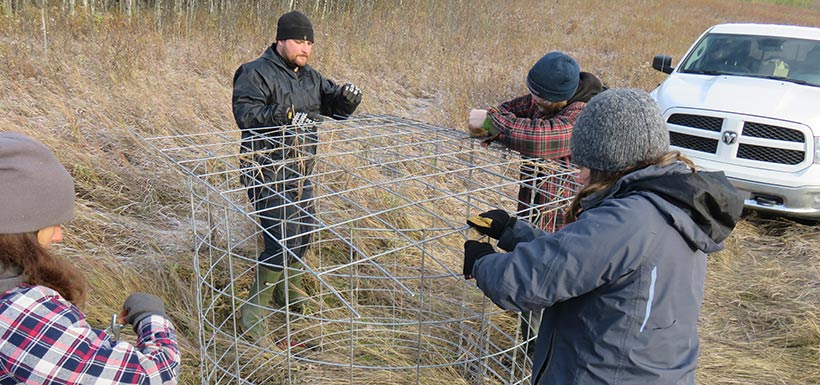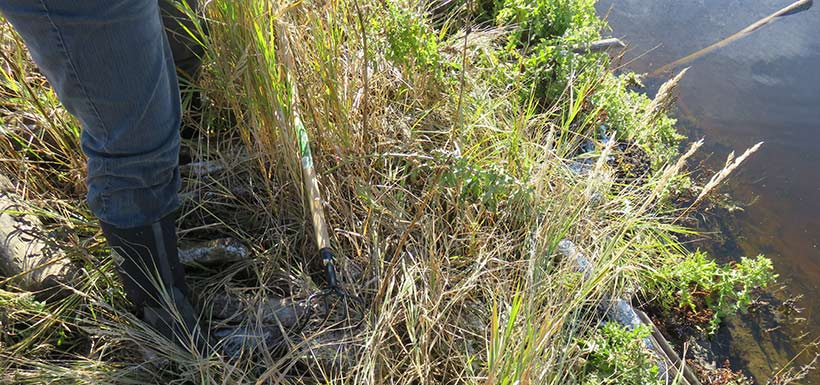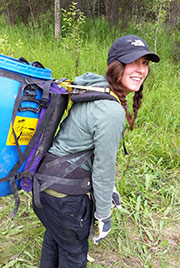Installing a pond leveller for beavers
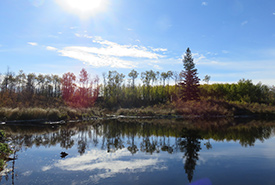
Wetland at the Kallal property, AB (Photo by NCC)
It was a crisp October morning and a thin layer of ice covered the surface of the wetlands as we drove out to the Kallal property. This site, located 40 minutes east of Edmonton in the Beaver Hills, was purchased by the Nature Conservancy of Canada (NCC) in 2010. It contains a mosaic of mixedwood aspen forests, grasslands, numerous wetlands and the slow-moving Hastings Creek.
I couldn’t help but feel a little relieved when I woke up to no snowflakes that morning, as I knew that could complicate things. We were planning to install a pond leveller through a sizeable beaver dam on the creek to mitigate upstream flooding on the property while allowing the beavers to remain on the property. The thought of tramping through ice cold water and snow was not appealing to me.
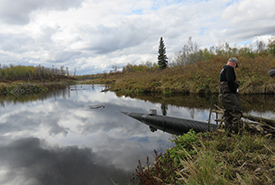
Pond leveller device (Photo by NCC)
Pond leveller devices are a cost-effective, low-maintenance tool in a landowner’s tool box, and they allow for a happy co-existence with beavers. Pond levellers are glorified pipes that extend through a beaver dam and prevent upstream flooding. Setting the pipe at the desired water level allows any excess water to flow through the pipe to the downstream side of the dam. This allows the beavers to remain in their dam, while alleviating upstream flooding nuisances.
Related blog posts
Six of us, made up of NCC staff, volunteers and partners from Cows and Fish, were equipped with two kayaks, 12 metres of plastic culvert piping, two hog panels (a type of fencing used for these types of projects), one makeshift inner tube-plywood flotation device, two cinder blocks, T-posts, and an assortment of tools and rope. We had the look of a crazy art project about to unfold.
First, we carefully assembled the device itself, by prepping and connecting the lengths of pipe, and creating the cage that goes around the intake side (this prevents the beaver from clogging it with sticks or mud). Next, we made a shallow trench at the top of the dam for the pond leveller to sit in. To accomplish this, we used a potato rake and our hands to dig out the twigs and mud.
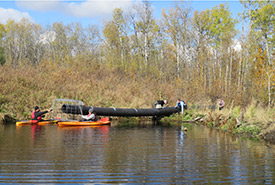
Kayakers helping guide the pond leveller device as we moved it on the dam toward our breach (Photo by NCC)
Then came the most challenging part: manoeuvering this strange, long contraption into place on the beaver dam. This involved some creative thinking, and a little luck.
Every beaver dam is different, and numerous factors impact the installation of a pipe leveller. Some things to consider include the size of the beaver dam, and if the beaver dam is accessible from shore. We decided to float the intake side out into the water (if the pipe fills with water during the installation it becomes too heavy to handle), and to shimmy it into place with a rope. Now, this is easier said than done. Luckily, that’s where our two expert kayakers came in to lend a hand. They helped guide the thing into place as we moved it on the dam toward our breach. This had its precarious moments, but after much effort, we were able to get it into the breached area. We secured it with nine-foot T-posts and cinder blocks to sink the intake side below the surface of the water.
There are a couple of considerations when planning a project like this. It is important for it to be an active beaver dam, as the long-term success of the pond leveller relies on the beavers to patch the dam so it doesn’t weaken over time and cause a blowout.
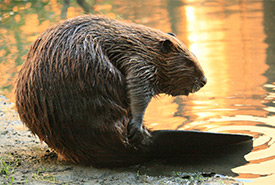
Beaver (Photo by Cheryl Reynolds)
It is also essential to make sure it is not too late in the season, because additional stress at such a critical time of year can negatively impact the beaver. Beavers cache food in the fall, collecting branches from trees and shrubs, which they float out onto the water and have close at hand to eat over the winter. Having a good food cache near their lodge reduces the number of time they need to go on land in the winter, which lowers their risk of being predated.
Though these devices don’t always work in every situation, they can be a great cost-effective solution to eliminating beaver-related headaches down the road. Information about the benefits of beavers can be found here.
A big thank you to Cows and Fish and to the volunteers who made this a success. Also, here is a great CBC segment talking about new perspectives on beavers.

